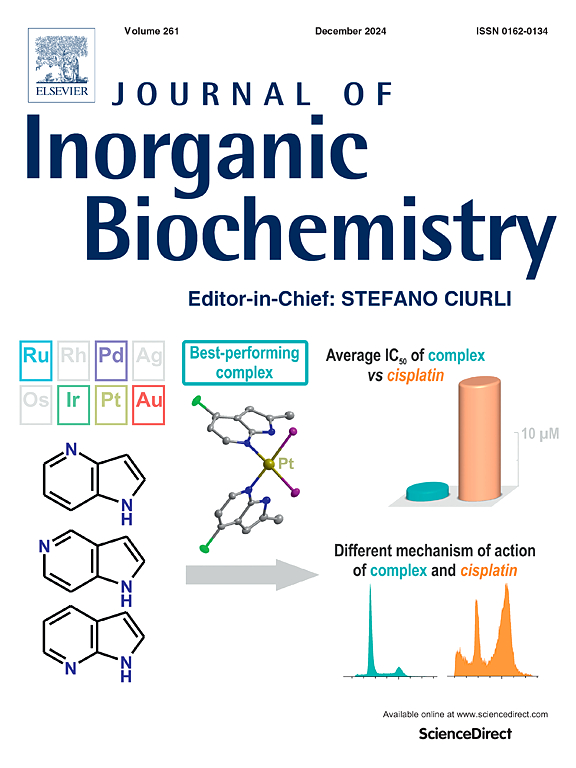Myxinidin-analogs 能够螯合 Fe(III):对抗铜绿假单胞菌生物膜的金属枪。
IF 3.8
2区 化学
Q2 BIOCHEMISTRY & MOLECULAR BIOLOGY
引用次数: 0
摘要
细菌有形成生物膜的趋势,在生物膜中,细菌生活在有组织的结构中,嵌入由 DNA、蛋白质和多糖组成的自生基质中。此外,细菌生长需要铁(III)作为必要的营养物质,并分泌嗜铁基团从环境中截留铁(III)。为了设计一种既能抑制细菌又能封存铁的分子,我们开发了两种基于羟基氨基甲酸酯的肽,它们来自我们实验室以前开发的抗菌肽 myxinidin 的类似物(WMR-4)。具体来说,我们建议将 WMR-4 与羟肟酸结合,从而产生 WMR-7 和 WMR-16 肽,这两种肽在抗菌分子和苷元之间的连接体长度上有所不同。通过一系列不同的生物物理实验对这两种肽进行了表征,以研究它们封存 Fe3+ 的能力。肽-铁(III)复合物在有机溶剂中通过紫外-可见光谱进行研究,以消除水的竞争,在酸性水中则通过紫外-可见光谱进行研究,以避免铁沉淀。我们还通过电化学、圆二色光谱和核磁共振光谱实验对复合物进行了表征。此外,我们还证明了肽铁(III)复合物抑制铜绿假单胞菌生物膜和影响细胞运动的能力。这种基于羟肟酸共轭的金属方法是一种很有前途的策略,能增强抗菌肽对铜绿假单胞菌等最危险细菌的抗生物膜活性。本文章由计算机程序翻译,如有差异,请以英文原文为准。

Myxinidin-analogs able to sequester Fe(III): Metal-based gun to combat Pseudomonas aeruginosa biofilm
Bacteria have developed a tendency to form biofilms, where bacteria live in organized structures embedded in a self-produced matrix of DNA, proteins, and polysaccharides. Additionally, bacteria need iron(III) as an essential nutrient for bacterial growth and secrete siderophore groups that sequester it from the environment. To design a molecule able both to inhibit the bacteria and to sequester iron, we developed two hydroxamate-based peptides derived from an analog (WMR-4), previously developed in our lab, of the antimicrobial peptide myxinidin.
In detail, we proposed a combination of WMR-4 with the hydroxamic acid resulting in the peptides WMR-7 and WMR-16 which differ for the length of the linker between the antimicrobial moiety and the siderophore. Both peptides were characterized through a set of different biophysical experiments to investigate their ability to sequester Fe3+. The peptide‑iron(III) complexes were studied through the UV–visible spectroscopy in organic solvent to eliminate water competition, and in acidic water to avoid iron precipitation. The complexes were also characterized by performing electrochemistry, circular dichroism and NMR spectroscopy experiments. In addition, we demonstrated the ability of peptide‑iron(III) complexes to inhibit the biofilm of Pseudomonas aeruginosa and to have an impact on the cell motility. This metal-based approach consisting in a hydroxamic acid conjugation represents a promising strategy to enhance the antibiofilm activity of antimicrobial peptides against one of most dangerous bacteria such as Pseudomonas aeruginosa.
求助全文
通过发布文献求助,成功后即可免费获取论文全文。
去求助
来源期刊

Journal of Inorganic Biochemistry
生物-生化与分子生物学
CiteScore
7.00
自引率
10.30%
发文量
336
审稿时长
41 days
期刊介绍:
The Journal of Inorganic Biochemistry is an established international forum for research in all aspects of Biological Inorganic Chemistry. Original papers of a high scientific level are published in the form of Articles (full length papers), Short Communications, Focused Reviews and Bioinorganic Methods. Topics include: the chemistry, structure and function of metalloenzymes; the interaction of inorganic ions and molecules with proteins and nucleic acids; the synthesis and properties of coordination complexes of biological interest including both structural and functional model systems; the function of metal- containing systems in the regulation of gene expression; the role of metals in medicine; the application of spectroscopic methods to determine the structure of metallobiomolecules; the preparation and characterization of metal-based biomaterials; and related systems. The emphasis of the Journal is on the structure and mechanism of action of metallobiomolecules.
 求助内容:
求助内容: 应助结果提醒方式:
应助结果提醒方式:


